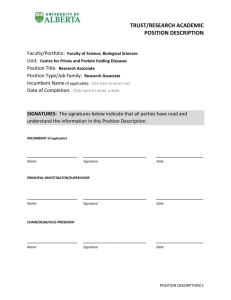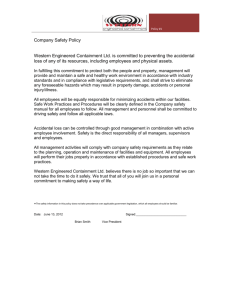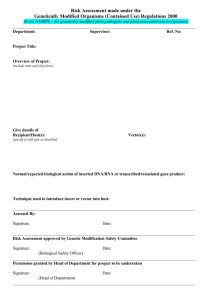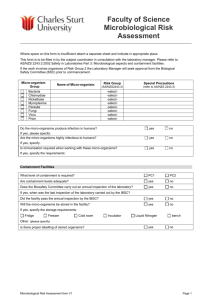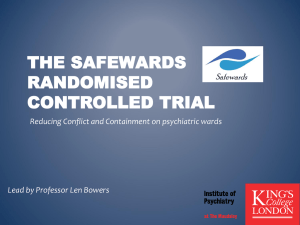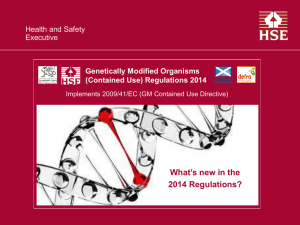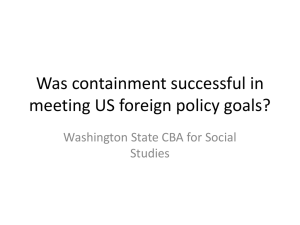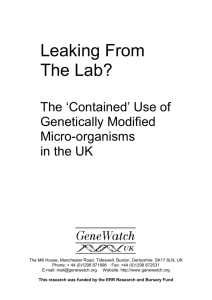Classification and assignment of final control measures
advertisement
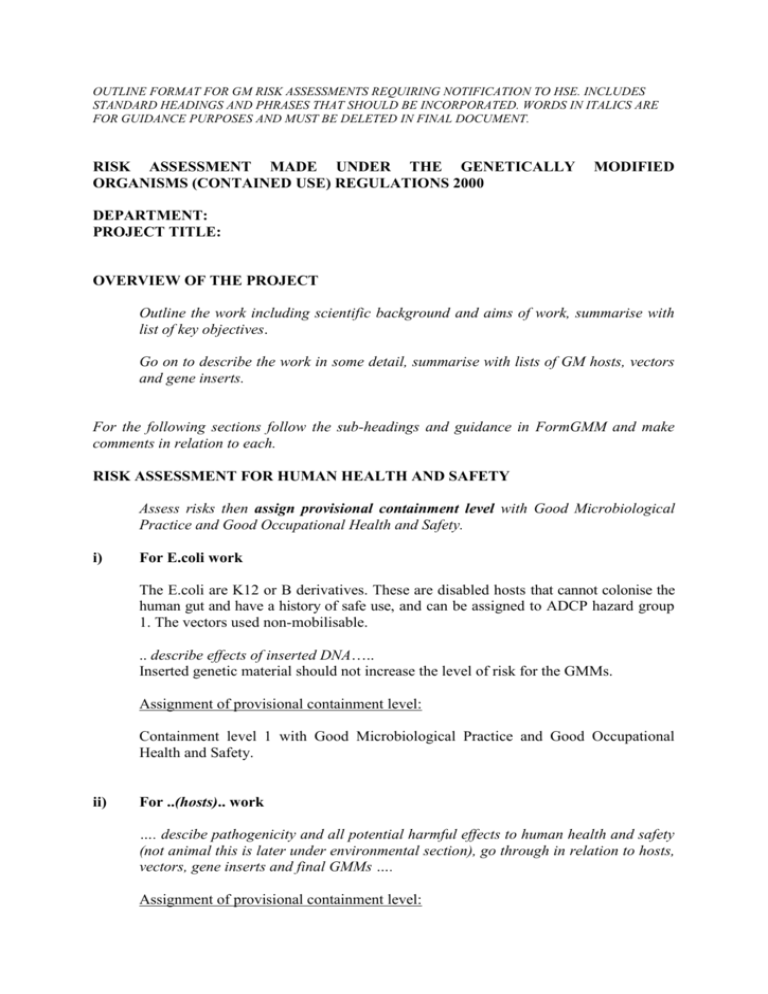
OUTLINE FORMAT FOR GM RISK ASSESSMENTS REQUIRING NOTIFICATION TO HSE. INCLUDES STANDARD HEADINGS AND PHRASES THAT SHOULD BE INCORPORATED. WORDS IN ITALICS ARE FOR GUIDANCE PURPOSES AND MUST BE DELETED IN FINAL DOCUMENT. RISK ASSESSMENT MADE UNDER THE GENETICALLY ORGANISMS (CONTAINED USE) REGULATIONS 2000 MODIFIED DEPARTMENT: PROJECT TITLE: OVERVIEW OF THE PROJECT Outline the work including scientific background and aims of work, summarise with list of key objectives. Go on to describe the work in some detail, summarise with lists of GM hosts, vectors and gene inserts. For the following sections follow the sub-headings and guidance in FormGMM and make comments in relation to each. RISK ASSESSMENT FOR HUMAN HEALTH AND SAFETY Assess risks then assign provisional containment level with Good Microbiological Practice and Good Occupational Health and Safety. i) For E.coli work The E.coli are K12 or B derivatives. These are disabled hosts that cannot colonise the human gut and have a history of safe use, and can be assigned to ADCP hazard group 1. The vectors used non-mobilisable. .. describe effects of inserted DNA….. Inserted genetic material should not increase the level of risk for the GMMs. Assignment of provisional containment level: Containment level 1 with Good Microbiological Practice and Good Occupational Health and Safety. ii) For ..(hosts).. work …. descibe pathogenicity and all potential harmful effects to human health and safety (not animal this is later under environmental section), go through in relation to hosts, vectors, gene inserts and final GMMs …. Assignment of provisional containment level: Containment level 2 with Good Microbiological Practice and Good Occupational Health and Safety. A microbiological safety cabinet and gloves will be used where appropriate. iii) For ..(GMM in animals).. work …describe NATURE OF WORK TO BE UNDERTAKEN Specify culture volumes and identify in particular any non-standard lab procedures. Assign any additional control measures for specific risks. i) For E.coli work The procedures are standard laboratory practice for gene cloning and manipulation. Culture volumes up to 1,000ml will be used. After consideration of the procedures to be undertaken, no need was identified for additional control measures to protect human health and safety when handling the genetically modified bacteria. ii) For ..(hosts).. work …describe what is being done including main techniques…. Possible options for inclusion: Where aerosols may be generated, for example homogenisation of tissues, a microbiological safety cabinet will be used. Genetically modified …. will be used for in vivo studies; infected animals will be handled and held at animal containment level 2 with the use of gloves where appropriate. The proposed experiments use small-scale cultures. After consideration of the procedures to be undertaken, no requirement was identified for additional control measures to protect human health and safety when handling the genetically modified organisms other than for in vivo work to be undertaken at animal containment level 2. iii) For ..(GMM in animals).. work …describe RISK ASSESSMENT FOR ENVIRONMENTAL HARM Assess risks and, where necessary, assign any additional control measures. i) For E.coli work No hazards to the environment were identified. The E.coli recipient strains K12 and B derivatives are disabled and cannot survive in the environment. Expression of inserted genes does not present a hazard. The vector is non-mobilisable. The resulting GMM would not survive outside laboratory conditions. Since it is non-colonising, and none of the inserted sequences would affect the level of risk, it would not be harmful to animals, plant or humans. As no hazards were identified, the consequence/severity of effects are negligible, the likelihood of effects being realised is negligible, and the risk to the environment is effectively zero. No additional control measures are needed to protect the environment. ii) For ..(hosts).. work ..include info on all species that can be infected, types of diseases caused, whether these are present in the UK, and specifically if vector transmission give details (if so must consider if anything in UK could act as vector)….. The consequence of the hazards being manifest are considered to be …. (select from severe/medium/low/negligible) and the likelihood of manifestation is ….. (select from high/medium/low/negligible) when containment assigned above is taken into account. In all cases, taking into account the control measures assigned above, the overall risks to the environment from the genetically modified micro-organisms produced in this work is …. (select from high/medium/low/effectively zero). Therefore no additional containment or control measures are considered necessary to protect the environment other than those described to protect human health and safety. (OR if risk is other than effectively zero assign additional control measures). iii) For ..(GMM in animals).. work …describe CLASSIFICATION AND ASSIGNMENT OF FINAL CONTROL MEASURES Mark up table 1a (and 1b or 1c as appropriate) and attach, assign to appropriate containment level and classify,. i) For E.coli work The containment and control measure that will be applied for work with these genetically modified micro-organisms are shown on Table 1. Containment level 1 will be applied with Good Microbiological Practice and Good Occupational Health and Safety. Class 1. ii) For ..(hosts).. work The containment and control measure that will be applied for work with the genetically modified …… are shown on Tables .. and … Full containment level 2 will be applied with Good Microbiological Practice and Good Occupational Health and Safety. A microbiological safety cabinet and gloves will be used where appropriate. Class 2. iii) For ..(GMM in animals).. work …describe WASTE MANAGEMENT MEASURES -- insert STANDARD PARAGRAPHS from Oxford University standard waste management measures - select/delete as appropriate from: Consumables (mainly plasticware eg pipettes, flasks, tubes) - autoclave using a make safe cycle as specified in BS 2646, Part 3, 1993 (either 121-125oC for at least 15 minutes or 126130oC for at least 10 minutes or 134-138oC for at least 3 minutes), discharge any excess liquids to drains, dispose of solids via clinical waste stream for incineration/dispose of solids via the industrial (black bag) waste stream for landfill. Liquids (eg samples, culture supernatants, tissue culture media) –autoclave using a make safe cycle as specified in BS 2646, Part 3, 1993 (either 121-125oC for at least 15 minutes or 126130oC for at least 10 minutes or 134-138oC for at least 3 minutes), discharge to drains. Agar plates - autoclave using a make safe cycle as specified in BS 2646, Part 3, 1993 (either 121-125oC for at least 15 minutes or 126-130oC for at least 10 minutes or 134-138oC for at least 3 minutes), discharge any excess liquids to drains, dispose of solids via clinical waste stream for incineration/dispose of solids via the industrial (black bag) waste stream for landfill. Sharps (eg needles, syringes, scalpels) - dispose via clinical waste stream for incineration. Animal bedding – EITHER autoclave using a make safe cycle as specified in BS 2646, Part 3, 1993 (either 121-125oC for at least 15 minutes or 126-130oC for at least 10 minutes or 134138oC for at least 3 minutes), dispose via the industrial (black bag) waste stream for landfill OR dispose via clinical waste stream for incineration. Animal carcasses - dispose via clinical waste stream for incineration. For waste items that are both radioactive and contain GMMs (include only if have waste that has both GMM and radioactive hazards) Consumables (mainly plasticware eg pipettes, flasks, tubes) - disinfect with 2% Virkon for at least 30 minutes, discharge any excess liquids to drains as aqueous liquid radioactive waste subject to limits contained in an authorisation granted under the Radioactive Substances Act 1993, dispose of solids as solid low level radioactive waste under an authorisation granted under the Radioactive Substances Act 1993. Liquids (eg samples, culture supernatants, tissue culture media) – disinfect with 2% Virkon for at least 30 minutes, discharge to drains as aqueous liquid radioactive waste subject to limits contained in an authorisation granted under the Radioactive Substances Act 1993. Degree of kill Autoclaving, effectively 100% kill (annual validation) Incineration, effectively 100% kill (licensed incinerator) [Include only if Radioactive+GMM only] Chemical disinfection with Virkon, used according to manufacturers instructions under standard conditions, manufacturers validation [eg4.79] log reduction ([eg99.998]% kill). Table 1a: Containment Measures for Activities involving GMMs in Laboratories Where an item is listed as "may be required" this indicates the item to be an option at that particular containment level and its requirement should be determined by the risk assessment for the particular activity concerned. Delete no or yes as indicated by risk assessment. Containment Measures Containment Levels 1 2 3 4 Isolated laboratory suite not required not required required required Laboratory sealable for fumigation not required not required required required Surfaces impervious, resistant and easy to clean required for bench required for bench required for bench and floor required for bench, floor, ceiling and walls Entry to lab via airlock not required not required may be required no / yes required Negative pressure relative to the pressure of the immediate surroundings not required may be required no / yes required required HEPA filtered extract and input air not required not required required for extract required for input and extract Microbiological safety cabinet/enclosure not required may be required no / yes required required (class 3) Autoclave required on site required in the building required in the lab suite required in lab (double ended) Access restricted to authorised personnel not required required required required Specified measures to control aerosol dissemination not required required so as to minimise required so as to prevent required so as to prevent Shower not required not required may be required no / yes required Protective clothing suitable protective clothing required suitable protective clothing required suitable protective clothing required complete change of clothing and footwear Gloves not required may be required no / yes required required Control of disease vectors (eg rodents, insects) which could disseminate GMMs may be required no / yes required required required Specified disinfection procedures in place may be required no / yes required required required Inactivation of GMMs in effluent from handwashing sinks, showers etc not required not required may be required no / yes required Inactivation of GMMs in contaminated material and waste required by validated means required by validated means required by validated means required by validated means Laboratory to contain its own equipment not required not required required required An observation window or alternative so that occupants can be seen may be required no / yes may be required no / yes required required Safe storage of GMMs may be required no / yes required required secure storage required Written records of staff training not required may be required no / yes required required CLASSIFICATION CLASS 1 CLASS 2 CLASS 3 CLASS 4 Table 1c: Containment Measures for Activities involving GMMs in Animal Units - TABLE 1a TO BE COMPLETED WITH THE FOLLOWING ADDITIONS/MODIFICATIONS: Where an item is listed as "may be required" this indicates the item to be an option at that particular containment level and its requirement should be determined by the risk assessment for the particular activity concerned. Delete no or yes as indicated by risk assessment. Containment Measures Containment Levels 1 2 Addition/ modification 3 4 Isolation of animal unit (note 1) may be required no / yes required required required modification Animal facilities (note 2) separated by lockable doors may be required no / yes required required required addition Animal facilities (cages etc) designed to facilitate decontamination (waterproof and easily washable material) may be required no / yes may be required no / yes required required addition Floor and/or walls and ceiling easily washable may be required no / yes required for floor required for floor and walls required for floor, walls and ceiling modification Appropriate filters on isolators or isolated rooms (note 3) not required may be required no / yes required required addition Incinerator for disposal of animal carcasses required to be accessible required to be accessible required to be accessible required to be on site addition Appropriate barriers at the room exit, and at drains and ventilation duct work required required required required addition Animals kept in appropriate containment facilities, such as cages, pens, tanks or isolator may be required no / yes may be required no / yes may be required no / yes may be required no / yes addition CLASSIFICATION CLASS 1 CLASS 2 CLASS 3 CLASS 4 Notes 1. 2. "Animal unit" means a building, or separate area within a building, containing an animal facility and other areas such as changing rooms, showers, autoclaves, food storage areas etc. "Animal facility" means a facility normally used to house stock, breeding or experimental animals or one which is used for the performance of minor surgical procedures on animals. 3. "Isolators" means transparent boxes where small animals are contained within or outside a cage; for large animals, isolated rooms may be more appropriate.
